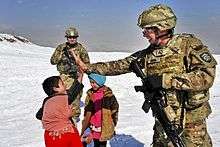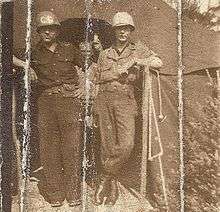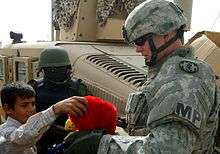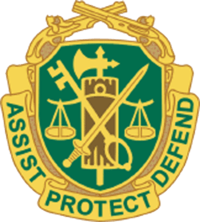Military Police Corps (United States)
| United States Army Military Police Corps | |
|---|---|
|
| |
| Active | 26 September 1941-present |
| Country |
|
| Branch |
|
| Part of | U.S. Department of the Army |
| Motto | "Of the Troops, for the Troops." |
| Branch Colors |
Green piped with yellow. Green – 65007 cloth; 67129 yarn; PMS 357. Yellow – 65002 cloth; 67108 yarn; PMS 123 |
| Engagements |
Civil War World War I World War II Korean War Vietnam War Persian Gulf War Kosovo War Operation Enduring Freedom Operation Iraqi Freedom |
| Commanders | |
| Commandant | Brigadier General Vereen |
| Insignia | |
| Branch Insignia |
 |
| U.S. Army Law Enforcement Shield |
 |
The Military Police Corps is the uniformed law enforcement branch of the United States Army. Investigations are conducted by Military Police Investigators or the United States Army Criminal Investigation Command (USACIDC), both of which report to the Provost Marshal General.
Some U.S. Army MP units, usually at the division or brigade level, are referred to as "combat MPs" or "line MPs", or more specifically as "division MPs" or "brigade MPs", and have combat zone responsibilities strikingly different from the law enforcement duties conventionally associated with the Military Police Corps, instead more closely resembling mission loads traditionally assigned to infantry units. These responsibilities consist of, but are not limited to, patrols including mounted and dismounted patrols as well as LP/OP (Listening Post/Observation Post) "static patrols", movement to contact, route reconnaissance, raids, cordon and search operations, and convoy and personnel escorts. Operationally, these duties still fall under the "Area security" and "Maneuver and mobility support" operational categories listed among the five main functions of the Military Police Corps (see section below). Since the beginning of the "Global War on Terror", military police have become a valuable asset to combat operations due to the versatility of the MOS.
Mission

The Army's Military Police provide an important function in the full spectrum of Army operations as a member of the Maneuver, Fires, and Effects division. The Military Police Corps provides expertise in police, detainment and stability operations in order to enhance security and enable mobility. The Army's Military Police can be utilized in direct combat and during peacetime.
- Function
The Military Police have five main functions:
- Maneuver and mobility support operations
- Area security operations
- Law and order operations
- Internment and resettlement operations
- Police intelligence operations
These five functions of the Army's Military Police all provide a commander with the necessary information and support for the successful completion of many Army missions.
- Career
The Military Police Corps has six career paths within the Army, one for commissioned officers, one for warrant officers, and four for enlisted soldiers: Currently 31 series, formerly the 95 series.
- 31A Military Police Officer
- 311A Criminal Investigations Warrant Officer;
- 31B (95B) Military Police
- 31D (95D) Criminal Investigations Special Agent
- 31E (95C) Internment/Resettlement Specialist
- 31K Military Police Working Dog Handler
History
The Military Police Corps is one of the youngest branches of the United States Army. It was officially established on 26 September 1941.
Military Police in the Revolutionary War
The Military Police Corps traces its lineage and history back to the American Revolution. General George Washington requested that the staff position of Provost Marshal be created to deal with disciplinary issues. In January 1776, William Maroney was appointed as the first Provost Marshal of the Continental Army.[1] The Provost Marshals relied on soldiers temporarily drawn from other units, and had difficulty enforcing discipline. On 20 May 1778, Congress established the Provost Corps, which General Washington referred to as the "Marechaussee."[1] Captain Bartholomew von Heer, a German-speaking officer from Pennsylvania, was appointed as the first commander of the Marechaussee on 1 June 1778.[1][2] Under the new organization, the Provost Marshal was responsible for soldiers under custody and for punishments, while the Marechaussee was tasked with the enforcement of order within the Continental Army. The Marechaussee Corps would be formed exclusively as a police organization, and was organized and equipped as light dragoons, utilizing their speed to aid in troop movements and moving prisoners from the battlefield. The Marechaussee protected the Army's rear and flanks during troop movements, searched for stragglers, guarded river crossings, and engaged in combat when needed, as in the Battle of Springfield.[3] The Provost Corps was disbanded in November 1783.[3]
Civil War
In 1863, the Office of the Provost Marshal General was established and oversaw the Veterans Reserve Corps (VRC). In the US Civil War, the VRC maintained law and order at garrison areas, while other provost guard units served on the front lines. After the war, the Office of the Provost Marshal General was discontinued as the Union Army disbanded.
Spanish–American War
During the Moro Rebellion following the Spanish–American War, the United States founded the Philippine Constabulary. Training began in 1902, and Brigadier General Harry Hill Bandholtz was appointed as chief of the Constabulary in 1907.[4]
World War I
The complexity of warfare during World War I required a corps of specially trained soldiers to handle massive numbers of prisoners of war and control the movement of troops and supplies in the zones of operation. The Military Police Training Department was established 9 September 1918 at Caserne Changarnier in Autun, France.[4] Following the war, Brigadier General Harry Hill Bandholtz, who had served as Provost Marshal of the American Expeditionary Forces, proposed the establishment of a permanent Military Police Corps. Although Congress failed to act upon this recommendation, it allowed for the permanent organization of Army military police units in the National Defense Act Amendment of 1920.[5]
In 1917, CPL Charles W. Baltimore, a black Military Police soldier stationed at Camp Logan, Texas, inquired into the beating of a black soldier by Houston police, and was himself beaten and arrested.[6] The racial tension which followed led to the Houston Riot, which killed four soldiers and sixteen civilians, and 60 black soldiers were executed or sentenced to life in prison.

World War II
During World War II, Military Police schools were established at Camp Gordon and Fort Benjamin Harrison, and MPs also trained for port security at Fort McHenry.[4] Military Police soldiers moved traffic along the Burma Road, supported amphibious operations on Normandy beachheads,[7] and managed enemy prisoners of war from Italy to the South Pacific. Thanks to the actions of 1LT John "Jack" Hyde and his detachment of MP, The Corps was heralded for gallantry at Remagen, as a fighting force in numerous combat actions and as peacekeepers at war’s end. In 1944, the Army again saw the need for a unit to investigate crime involving soldiers in Europe. The United States Army Criminal Investigation Division was established as a branch of the Provost Marshal General’s Office and has continued investigative activity since.
After the war ended, cavalry units in Germany were utilized to form the United States Constabulary, a police-like patrol organization. It was disbanded in the 1950s.
In 1949, the newly formed Defense Department was in the process of reorganizing the Army and plans were developed to disband the Military Police Corps. But when Congress passed the Army Reorganization Act in May 1950, the Corps survived, remaining a separate branch of the Army.

Korean War & Vietnam War
When North Korea invaded South Korea in June 1950, there were some MP units stationed in Korea. One of those was the 55th Military Police Company, which had been assigned to Camp Ascom in December 1948. Most of those military police units that arrived during the early months of the war came from Japan, where they were serving as occupation forces following World War II. While the majority of MP companies came from outside Korea, most of the battalions of the Korean War were formed on the peninsula
During the Korean war, Military Police kept supply routes open. Subsequently, Military Police monitored the exchange of prisoners and patrolled the demilitarized zone. Military Police, adapting to a different style of warfare in Vietnam, earned status as a combat support arm, partially as a result of combat success during the Tet Offensive.[8]
Current Role
During Operation Just Cause, Operation Desert Shield and Storm, the Military Police provided area security, conducted battlefield circulation control, and exercised custody over thousands of prisoners. Since 1991, the Military Police have assisted with interventions in Somalia, Haiti and Bosnia. Military Police maintained order in war-torn Kosovo, as well as keeping the peace in Afghanistan. During the 2003 invasion of Iraq, MPs were used extensively to maintain control over the large numbers of detainees being held by coalition forces, as well as helping to conduct raids, convoy security and regular patrols. MPs were the main force responsible in rebuilding and training the Iraqi Police. Ever since the invasion, military police have been one of the most heavily engaged MOS's in the Iraqi theater due to the constant exposure outside the wire.
In the United States, MPs often provided disaster relief and internal security, while still fulfilling their fundamental function of maintaining discipline and security within the Army. The Military Police Corps has been a very busy organization during the years of its existence, and as one of the most deployed branches of the Army, it appears that it will remain so for the foreseeable future.
Women in the Military Police Corps

Women in the Women's Army Auxiliary Corps were assigned Military Police duties as early as 1941.[9] By 1943, soldiers in the Women's Army Corps were trained as Military Police in order to police female soldiers, although they had jurisdiction over all soldiers, including males.[9] Women have since served in the Military Police Corps, which has given the regiment some distinction. (In the 1953 Film Off Limits, Bob Hope plays a character who joins the Military Police so he can train with women.) Female MPs have crossed many gender barriers in the United States Armed Forces.
- In the 1983 Invasion of Grenada, 4 female MPs from the 118th Military Police Company (Airborne) were deployed to Grenada. Conflicting views of Women in combat caused them to be ordered back to the United States, only to be ordered back to Grenada days later.[10]
- In the 1989 United States invasion of Panama, CPT Linda Bray led the 988th Military Police Company in an assault against Panamanian Defense Forces, and is considered the first woman to lead U.S. troops in combat.[11] CPT Bray was awarded the Commendation Medal for Valor.[12]
- SGT Leigh Ann Hester became the first woman since World War II to receive a Silver Star, for her actions in Iraq on 20 March 2005.[13]
- Tulsi Gabbard became the first female to graduate Alabama Military Academy as the OCS distinguished honor graduate in March 2007,[14] and one of the first women combat veterans to serve in United States Congress.[15]
- In 2010, Brigadier General Colleen L. McGuire became the first woman to hold the office of Provost Marshal General of the Army.
- In 2015, CPT Kristen Griest, a military police commissioned officer, became one of the first two women to successfully complete U.S. Army Ranger School.[17]
Women now make up 25% of the MP Corps.[18] The mixed-gender MP Corps is valued in the wars in Iraq and Afghanistan, where cultural taboos may prevent male soldiers from interacting with women.[19]
Modern U.S. Army Military Police
Uniforms

In the U.S. Army, a simple patch with the legend "MP" worn on the left arm distinguishes a military police soldier wearing the new Army Combat Uniform (ACU). This patch is attached to the uniform by velcro. For both garrison law enforcement duty as well as for tactical field work, the patch is a subdued gray with black lettering.
U.S. military police used to be distinguished by a brassard worn on the left arm when on duty in previous uniform versions such as the Battle Dress Uniform. The brassard was black with white lettering for garrison law enforcement duty and could include extra designations such as "Customs MP" or "K-9 MP" (for dog handlers). Tactical brassards were green with black lettering for temperate climates and sand with light brown lettering for desert duty.
When wearing a Class A (suit) or B uniform they are authorized to wear combat boots instead of regulation low-cut shoes. However, like Airborne soldiers who may only wear the boots while on jump status, MPs may only wear these boots with Class A or B uniforms when performing law enforcement duties.
During World War II, the emblems used were a wide white band around the helmet or a white helmet liner or a white peaked cap, a white webbing Sam Browne belt, white gloves, and white gaiters, atop the standard olive drab uniform. From this clothing, the nickname they were given by the British civilians at the time was "snowdrops." An MP armband was also worn on the left arm, usually black or dark blue with white letters.
Weapons
The standard personal weapons of the United States Army military police are the 9mm M9 pistol, the M4 carbine, the M203 grenade launcher, the M249 Squad Automatic Weapon (SAW) or M240B, and the Mossberg 12-gauge pump action shotgun. MP team leaders are typically assigned an M4 with an M203 attached, drivers are assigned an M249, and gunners are assigned an M4 in addition to any other crew-served weapons they are responsible for.
Crew-served or vehicle-based weapons used by MP fireteams include the M2 Browning machine gun, M240B, and Mk 19 grenade launcher, and MP teams often carry one or two AT4 anti-tank weapons as well.
Military Police also employ K9 Military Working Dogs.
Units
Military Police are considered maneuver support, and MP units may be organized at many different levels, based on the size of the unit it is meant to support. An Army Corps may contain one MP brigade, which is responsible for training and supplying subordinate Military Police units. When MP units are deployed, their parent unit may maintain administrative control (ADCON) while relinquishing tactical control (TACON) to the deployed unit being supported. Smaller MP units are also organic to maneuver units. An infantry division, for example, contains an organic MP Company, while a maneuver Brigade combat team includes an MP platoon or cell.
Military Police Investigations
The Military Police Investigations (MPI) office is usually responsible for the investigation of crimes, such as crimes against property under $5,000.00 and crimes against persons except murder and rape (handled by the CID) committed on a military installation, but they may investigate other crimes in certain circumstances. MPI personnel are enlisted MPs who go through a special course at the Military Police School at Fort Leonard Wood, Missouri.
Heraldic items
Branch insignia

- Two crossed gold color metal pistols 3/4 inch in height.
- The insignia was approved in 1922.
- The M1805 pistol, sometimes referred to as the Harper's Ferry Pistol (Harper's Ferry Model 1805)(made at the Harper's Ferry Arsenal), was selected since it was the first American military pistol and remained the Army model for many years. The parts of this weapon were standardized and inter-changeable, thereby marking an advance in arms production.
Branch plaque

- The plaque design has the branch insignia, letters, and rim in gold. The background is green.
Regimental insignia

- A gold color metal and enamel device 1 3/16 inches in height consisting of a shield blazoned as follows: Vert, a fasces palewise, axe Or and rods Proper (brown), thereover in fess a balance and in saltire overall a key with bow in sinister base and a sword with hilt in dexter base all of the second.
- The shield is enclosed at bottom and sides by a gold scroll of three folds inscribed ASSIST PROTECT DEFEND in green letters and surmounted at the top by two crossed gold pistols.
- The regimental insignia was approved on 3 July 1986.
Regimental coat of arms

- Description
- The coat of arms appears on the breast of a displayed eagle on the regimental flag.
- The coat of arms is: Vert, a fasces palewise, axe Or and rods Proper (brown); thereover in fess a balance and in saltire overall a key with bow in sinister base and a sword with hilt in dexter base all of the second.
- The crest (On a wreath of the colors Or and Vert a pair of crossed pistols of the first) is displayed above the eagle's head.
- The background color of the flag is green and the fringe is yellow. The coat of arms was approved on 2 May 1986.
- Symbolism
- Green and gold are the colors associated with the Military Police Corps.
- The fasces is an ancient symbol of authority related to a Roman magistrate.
- The balance is symbolic of equal justice under law and the key signifies security.
- The sword represents the military.
- The crossed pistols are the symbol of the Military Police Corps mission: to uphold the law and to keep order.
- The motto ASSIST, PROTECT, DEFEND reflects the mission.
Branch colors
- Green piped with gold.
- The color yellow piped with green was assigned to the Military Police by Army Regulation 600-35 dated 20 April 1922.
- With the establishment of gold for the Armor and the use of green for the insignia on the Armor flag, the colors for the Military Police were reversed.
- The current colors, green piped with gold, were assigned by Army Regulation 600-60-1 dated 26 October 1951.
See also
- List of United States federal law enforcement agencies
- List of United States Army Military Police Units
- Military police
- Military law
- United States Air Force Security Forces
- United States Constabulary (defunct)
- United States Pentagon Police
- Department of the Army Civilian Police
- Department of the Air Force Police
- United States Marine Corps Civilian Police
- United States Coast Guard Police
References
- 1 2 3 Valuska, David L.; Reppert, Byron. "The Marechausee: von Heer’s Provost Corps. A Pennsylvania German Unit". Retrieved 12 November 2011.
- ↑ Ruppert, Bob (2014). "Bartholomew von Heer and the Marechaussee Corps". Naperville, IL: Journal of the American Revolution.
- 1 2 "Military Police Corps". GlobalSecurity.org. 2000. Retrieved 12 November 2011.
- 1 2 3 "History of the United States Army Military Police School (USAMPS)" (PDF). Fort Leonard Wood, Missouri: Military Police Regimental Association. p. 6. Retrieved 16 November 2011.
- ↑ Wright, Jr., Robert K. (1992). "Army Lineage Series: Military Police". United States Army Center of Military History. p. 9. Retrieved 12 November 2011.
- ↑ Smith, C. Calvin (1991). "The Houston Riot of 1917, Revisited" (PDF). Houston Review 13 (2): 91. Retrieved 12 November 2011.
- ↑ "MP: The Story of the Corps of Military Police". Stars and Stripes.
- ↑ Rogers, Jim (10 September 2015). "Tet Offensive: The battle that changed MP history". Fort Leonard Wood: Guidon. Retrieved 15 September 2015.
- 1 2 Craig, Dr. Ronald (Winter 2011). "History of Women in the Military Police Corps" (PDF). Military Police Regimental Association Quarterly 22 (2): 36. Retrieved 22 November 2011.
- ↑ Monahan, Evelyn; Neidel-Greenlee, Rosemary (2010). A few good women: America's military women from World War I to the wars in Iraq and Afghanistan. Random House Digital, Inc. p. 331.
- ↑ "History Archive:Linda Bray". Women in Military Service for America Memorial Foundation. Retrieved 12 November 2011.
- ↑ Biesecker, Michael (25 January 2013). "Linda L. Bray, First Woman To Lead Platoon In Combat, Thrilled With Lifting Of Ban". Huffington Post. Retrieved 25 January 2013.
- ↑ Cucullu, 149
- ↑ "Akaka Staffer Graduates Army Officer Training at the Top of Class". Retrieved 31 July 2010.
- ↑ Huang, Cindy (12 November 2012). "Meet Veteran, Representative-elect Tulsi Gabbard". PBS. Retrieved 12 November 2012.
- ↑ Castro, Jeffrey (15 January 2010). "First woman becomes Army provost marshal general". Army News Service. Retrieved 22 November 2011.
- ↑ Tan, Michelle (19 August 2015). "First women to earn Ranger Tab are MP and Apache pilot". Army Times. Retrieved 19 August 2015.
- ↑ Chapman, Anne W. (2008). Mixed-Gender Basic Training. The U.S. Army Experience, 1973-2004 (PDF). Fort Monroe, Virginia: U.S. Army Training and Doctrine Command. p. 161. Retrieved 12 November 2011.
- ↑ Cucullu, 252
Further reading
- Cucullu, Gordon; Fontana, Chris (2011). Warrior Police. Rolling with America's Military Police in the World's Trouble Spots. New York: St. Martin's Press. ISBN 978-0-312-65855-7.
- Robert K. Wright Jr., ed. (1992). Military Police. Army Lineage Series. United States Army Center of Military History.
- MP: The Story of the Military Police in WWII
- US Army Lineage Series Military Police
- History of the Military Police School
- History of the Military Police Corps
- 545th MP Comp Cavalry MP
External links
| ||||||||||||||||||||||||||||||||||||||||||||||||||||||||||||||||||||||||||||
| ||||||||||||||||||||||||||||||
